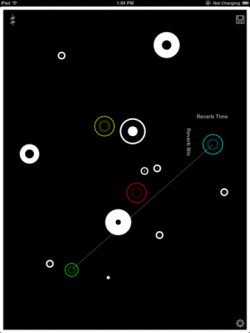 Developer Refined Stochastic Technology has released Bucephalus for iOS – a free app that lets you experiment with physics-based generative music.
Developer Refined Stochastic Technology has released Bucephalus for iOS – a free app that lets you experiment with physics-based generative music.
Features:
- Five ball sizes controlled globally
- Variable hardness and resonance
- Add up to 20 balls (6 on slower processors)
Additional features (available via in-app purchase):
- Custom designed three stage, four parameter chamber reverb
- Two parameter custom distortion
- Three filter types with adjustable Q and cutoff frequency
- Save states
- Variable elasticity, gravity and resonance
- User defined resonance settings with Major7, Minor7, Dominant7, Semitone, Wholetone and Pentatonic arpeggios and variable detuning for microtonal effects
Here’s a preview of Bucephalus in use:
Bucephalus is a free download, but advanced features are in-app upgrades.

Tried it but I don’t get any sound just some balls that fall around the screen very fast. Every thing you click on brings up a message asking if you want the ‘advanced upgrade’, which I assume means in-app purchase? One for the delete bin I think.
Yep, this is deceiving people on a major scale. Just name your price if you mean to give us shit for free, man.
Agreed. No sound. Unclear in-app purchases, and almost useless without advanced features. Not the way to sell in-app purchases or build a developer reputation.
Could you please explain what is happening for you regarding the lack of sound?
Thanks, Jon (RST)
Totally useless app. Not free at all. You have to make an in-app purchase if you want more than one sound and one pitch.
You have five different ball sizes/pitches/scales to play with in the free version!
**********
Allthough this would be great if it had midi to be used as a sequencer.
I can add this in the next version. Any ideas on how you’d like it to work?
Jon (RST)
@Geir:
Try this, it might be closer to what you’re after:
https://itunes.apple.com/gb/app/amos-another-midi-osc-source/id403939169?mt=8
I got it, and like it 🙂 But I would like the balls to be smaller, or better yet to be able to scale them. This one has small balls, which would give more sequencial opportunities….. well, I think it would at least 😛
^^^ mad because they have to pay for something.
Synthtopia interpreted the iTunes page incorrectly. It quite clearly lists the above features as “Advanced”. The free version is enough to play with all of the different ball sizes – just as fixed pitches but still with variable resonance.
From the dev.
We noted that some features were in app purchases but this was confusing to people. I updated the article to be more explicit about which features were the advanced ones, and to match the iTunes listing.
@Daniel:
I think the issue is more to do with the fact that there is no mention of any IAP until you start using it, and people like to know upfront if there are any additional charges, rather than the cost of them.
Each case is different though; with TableTop for example, it does seem to be an issue of the cost of each device, over any sort of ‘shady’ shenanigans.
It must be difficult for developers to know what to charge for their hard work, and what to offer as an IAP; as Apple doesn’t allow developers to charge for updates, I can understand why they may choose to have IAPs; I wouldn’t fancy spending a month or two programming new features, if I was only going to make money from any new sales; it must be a minefield.
Got a bit OT there, but people often have very strong opinions regarding IAPs; and I do like to try and see it from all sides.
They key to the in-app purchase model is giving people an app that they like and they will use enough that they’ll consider unlocking the additional features.
i cant understand why a grown plataform dont have good free apps. thats a shame.
developers aways trying to recover their investments on the apple dev´s license or?
What don’t you understand? Developers have rent to pay too!
http://refinedstochastic.wordpress.com/2013/02/27/bucephalus-iap-and-anger-management/
New video of upgrade looked very intriguing. Like a bouncing ball version of Borderlands. Um, no…
I am a sucker, paid for the upgrade, no dice trying to actually hear your own samples. I cannot believe Audiobus approved this…
It is incredibly buggy, sounds in the presets not remotely reflected in the playing field, when you use it for a while, it just starts to go all gltchy in a bad way, and you want to just kill it. The developer is being very complacent about addressing user needs. MAKE THE THING WORK! It simply does nothing it is supposed to in any useable way yet.